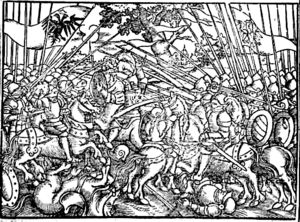Battle of Hundsfeld facts for kids
Quick facts for kids Battle of HundsfeldGerman: Schlacht von Hundsfeld Polish: Bitwa na Psim Polu |
|||||||
|---|---|---|---|---|---|---|---|
 Woodcut from Kronika Polska by Marcin Bielski, 1597 |
|||||||
|
|||||||
| Belligerents | |||||||
| Kingdom of Poland | Holy Roman Empire | ||||||
| Commanders and leaders | |||||||
| Bolesław III Wrymouth | Henry V of Germany | ||||||
The Battle of Hundsfeld (also known as the Battle of Psie Pole) was a famous battle that supposedly happened on August 24, 1109. It took place near the city of Wrocław in Silesia, which is now part of Poland. This battle was fought between the Polish army and forces from the Holy Roman Empire.
The Holy Roman Empire was trying to help a Polish duke named Zbigniew. He wanted to take back his power from his half-brother, Bolesław III Wrymouth, who was the ruler of Poland. A Polish writer named Wincenty Kadłubek wrote about this battle many years later.
Contents
The War with the Holy Roman Empire
Why the Battle Happened
A writer named Gallus Anonymus wrote about the wars happening around 1112 to 1118. He mentioned several fights with the army of the Holy Roman Empire. These forces were led by King Henry V of Germany.
Before this, the Polish ruler, Bolesław III, had attacked the land of Bohemia. This made the German king, Henry V, very upset. So, King Henry V decided to start his own military campaign in Poland.
The German Invasion
King Henry V's army first tried to capture the towns of Bytom Odrzański and Głogów. A "siege" is when an army surrounds a town to try and force it to surrender. After these attempts, the German army moved along the Oder River.
They marched towards Wrocław, a major city. However, they were not successful in taking Wrocław. The Polish forces, led by Bolesław III, defeated them at the Battle of Hundsfeld.
What Really Happened?
The Story of Wincenty Kadłubek
According to the writer Wincenty Kadłubek, the Polish army surprised the Germans. He wrote that Bolesław III Wrymouth's forces won a complete victory. After this defeat, King Henry V and his army left Poland.
Kadłubek also wrote about what happened after the battle. He said there were so many dead and dying soldiers left on the battlefield. He claimed that dogs started eating the bodies. This made the dogs so wild that no one dared to go near the area. Because of this, the place became known as "dogs' field." In Polish, this is Psie Pole, and in German, it is Hundsfeld.
Historians' Debate
Later, in the late 1800s, some people started to question Kadłubek's story. Today, historians are still not sure about all the details of the battle. Some historians believe it was not a huge battle, but rather a smaller fight.
Kadłubek's book was written almost 100 years after the battle. It was written for Bolesław's son, Casimir II the Just. So, some historians think the story might not be completely accurate. However, even if it was a small fight, it still helped cause King Henry V to leave Poland.
The Name Lives On
Today, the area known as Psie Pole is a part of the modern city of Wrocław. The name "Psie Pole" was also used again much later. During WWII, General Stanislaw Maczek gave this name to an area in Normandy. This was after a long line of German tanks was destroyed there during the Battle of Falaise.
See also

